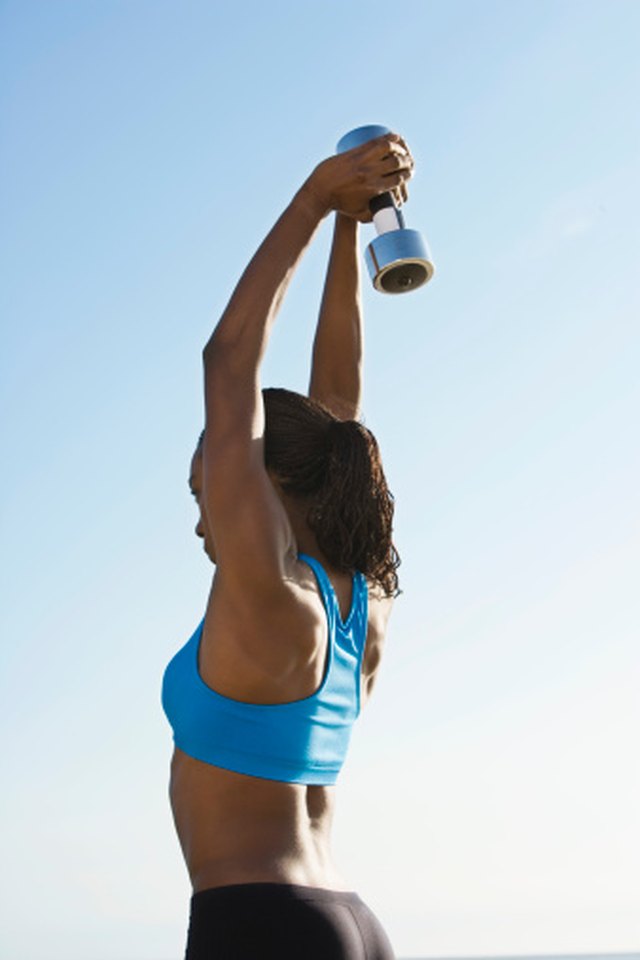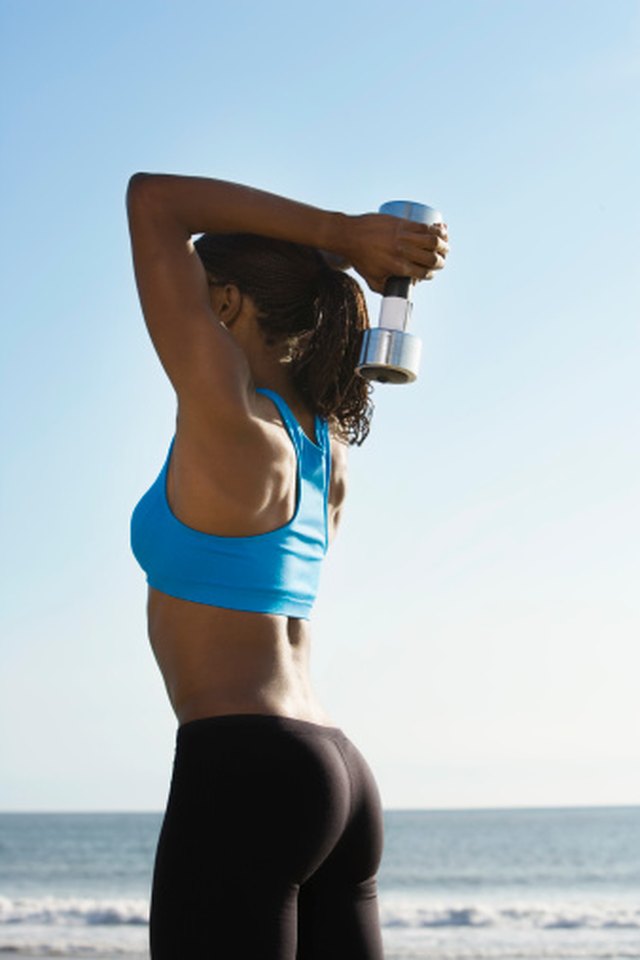What Is the Exercise When You Lift a Dumbbell Behind You?

Dumbbells are a highly versatile piece of workout equipment that can be used to strengthen a wide variety of body parts. There are several exercises that require you to lift a dumbbell so that it ends up behind the body. Two of these exercises target your triceps, while one of them targets your shoulder and back muscles. Choosing which exercise to perform is as simple as choosing which body part you want to work and can be performed anywhere you have a set of dumbbells.
Overhead Triceps Extension

JTPhoto/Brand X Pictures/Getty Images
The overhead triceps extension requires you to move a dumbbell from behind your body so that it is supported by your hands overhead. To perform, grab a dumbbell between both of your hands so that you are supporting the weight evenly between the two hands. Your hands should be positioned so that your thumbs overlap each other and your index fingers overlap each other. Your arms should be at full extension above your head with the weight being supported overhead. Now bend at your elbows, allowing your forearms to slowly descend toward the floor. Your elbows should remain in the same position throughout the movement. Once your forearms are parallel to the floor and the weight is located behind your head, extend your arms slowly back up by contracting your triceps. Once your arms have reached full extension, you can repeat descending and raising the weight.
Triceps Kickback
The triceps kickback requires you to extend the dumbbell behind your body from a bent-over position. To perform, place your left knee and left hand on a bench while bending over at your waist. Your back should be parallel to the floor with your right leg supporting the rest of your body weight. Grab a dumbbell in your right hand and move your upper arm so that your upper arm and elbow are also parallel to the floor and in-line with your back. You should have a 90-degree angle at the elbow joint with your forearm facing directly toward the floor. Now, extend your arm slowly backward until your forearm forms a straight line with your upper arm and elbow. Hold this position briefly and then lower your forearm back to the 90-degree position.
Reverse Fly
The reverse fly is the exercise that works the muscles in your back while bringing the dumbbells behind you. To perform this exercise, grab a pair of dumbbells so that your palms are facing toward each other. Bend over at your waist 45 degrees and bend your knees slightly. Allow your arms to hang toward the floor. Now, lift your arms upward trying to form a “T” shape between your arms and back. This means your arms will form a straight line with your back. Once the weights are just above the height of your back, hold the T shape for a brief moment and then allow your arms to slowly descend back toward the floor.
Considerations
Form is crucial for each of these lifts because it is hard to visualize the motion due to the location of the weights, unless you have a mirror. Therefore, you should have a partner for each lift to ensure your form is correct and that you are in a safe position at all times. This is especially true for the overhead triceps extension exercise since it requires the weight to be overhead. Your partner should stand with both hands close to the weight at all times to prevent the dumbbell from falling on your head as you lift.
Explore In Depth
References
- American Council on Exercise: Standing Dumbbell Overhead Tricep Extension
- American Council on Exercise: Dumbbell Triceps Kickback
- Landin D, Thompson M, Jackson M. Functions of the Triceps Brachii in Humans: A Review. J Clin Med Res. 2018;10(4):290-293. doi:10.14740/jocmr3340w
- Tiwana MS, Sinkler MA, Bordoni B. Anatomy, Shoulder and Upper Limb, Triceps Muscle. StatPearls. Updated 2020
Resources
- "NASM Essentials of Personal Fitness Training"; April 2007
- "ACSM's Resources for the Personal Trainer"; American College of Sports Medicine; 2007
Writer Bio
Joshua Bailey has been writing articles since 2006 with work appearing at Bodybuilding.com and 2athletes.com. Bailey holds the following certifications: NASM-CPT, NASM-PES, NASM-CES and NSCA-CSCS. He also holds a Bachelor of Science in exercise and sports science from the University of North Carolina, Chapel Hill and a Master of Science in exercise physiology from the University of North Carolina, Greensboro.
